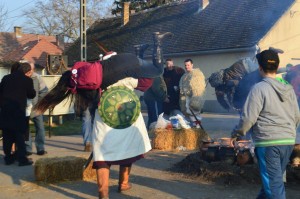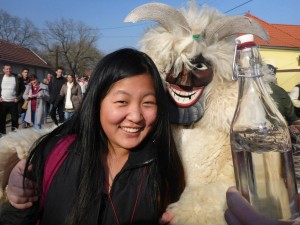While Claremont seems to be in a perpetual state of summer and sunshine, other parts of the world experience (believe it or not!) such things as snow and winter! Here in Hungary, where I am studying abroad this semester, we’ve been fighting off the cold with plenty of hot chocolate, mulled wine, and cozy socks, but the locals in the Hungarian village of Mohacs have a more festive way, and it’s called the Busójárás.

The Busójárás, or “Buso Walking,” is a centuries-old festival held at the end of every winter. It consists of food, families, traditional dancing, parades, a bonfire, and what seems to be thousands of people dressed in Buso costumes. Large, heavy, furry costumes.
Throughout the year, the people who dress as Busos help with the community and harvest, making it their mission to keep up the historical traditions of their town. They learn about carving and the traditional dances and folklore. But when the time comes for the festival, their job is to storm the town and make as much commotion as possible, yelling, running, and hugging the people to wake up the languid citizens of winter.
The origin of the festival is unknown, but one common explanation is that the original Busos came in with their noisemakers and horns and costumes and masks to scare away the Ottomans, who at the time were ruling Hungary. It has evolved to its present day state, a busy, boisterous celebration.

An important part of their welcoming of spring is the celebration of fertility. These Busos, mostly men, pay a lot of attention to the women who attend the festival, running up to them, hugging them, ruffling up their hair, and “waking up the blood,” as my tour guide said. At some point, a few Busos even picked up me and my friend, threw us over their shoulders, and set us down on a stack of hay before offering us some hot mulled wine (or forralt bor, in Hungarian).
The atmosphere at the festival was light and teasing. The Busos were running after the women, and the women were laughing and running away, until the Busos caught up and embraced them in a hug. A few sexual innuendos involving the sticks they were carrying were thrown into the mix. We even saw little Busos, no more than ten years old, joining in on the fun.
We all had a great time at the festival, but afterward, I couldn’t help but feel a little conflicted. I kept thinking about the conversations on campus about consent culture, since the very first days of orientation before freshman year. I kept thinking about how not only should “no mean no,” but the absence of enthusiastic consent should also mean no, in any context, sexual or not. While it was clear that the Busos were playful and joking during their interactions with us, running away from them or shying away from their hugs meant that they would try harder to hug you.
At the same time, I know that I shouldn’t go to a different country and expect the same conversations as the ones I had at Pomona. I also know that the hugging and touching at the Busójárás is not a representation of daily interactions; men here on the streets of Budapest do not generally run around trying to hug women. The behavior was seemingly isolated to the festival. And yet I can’t help but wonder if what I saw in that context was problematic.
Perhaps, since I am abroad looking to experience a new culture, I should simply note that I did see something different. Maybe I should just take the Busójárás Festival for what it was, a celebration of fertility and the awakening of spring.
